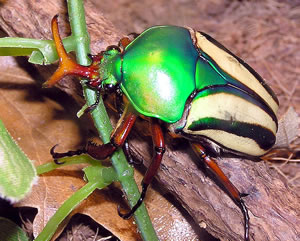Insects make up about three fifths of all of all known plant and animal species on Earth.
Close to one half of all insects in the world are beetles.
About one million insect species have already been described, and there could be as many as ten million different species of insects in the world.
One reason insects are so diverse and tremendously successful is that their basic structure is highly adaptable and their organ systems can take on roles for which they were not primarily designed.
 For example, the stings of bees, some ants and wasps are derived from the egg-laying apparatus.
For example, the stings of bees, some ants and wasps are derived from the egg-laying apparatus.
The sounds of cicadas and some cockroaches are amplified or produced by the respiratory system.
The silk of lacewing larvae is secreted from the excretory organs.
Because most insects are small, they have been able to occupy a vast range of microhabitats that would be unsuitable for larger species. The most common size of an insect is about 1/4 inch (3-5 mm).
The nervous system of insects is highly developed. They are able to discriminate subtle differences in their environment and identify the boundaries of their microhabitats.
Insects' highly developed nervous system also allows them to engage in complex behavior, which includes developing social relationships.
How Insects Adapt
Because individual insects have very short lifespans, they do not need to learn to adapt to new conditions.
Instead, entire species develop genetic adaptations. These adaptations can occur quickly because of the short amount of time between generations.
For example, insects can easily acquire a resistance to insecticides through a change in the genetic composition of the population of the insect species.
Conflict Between Insects and Plants
As insects have evolved, they have interacted with all types of flowering plants.
More than half of all insects are herbivores. Many flowering plants produce toxins or distasteful compounds to discourage insects from eating them.
However, certain insect species are able to develop metabolic reactions that detoxify these compounds.
This constant conflict between plants and insects often leads to the creation of new species.